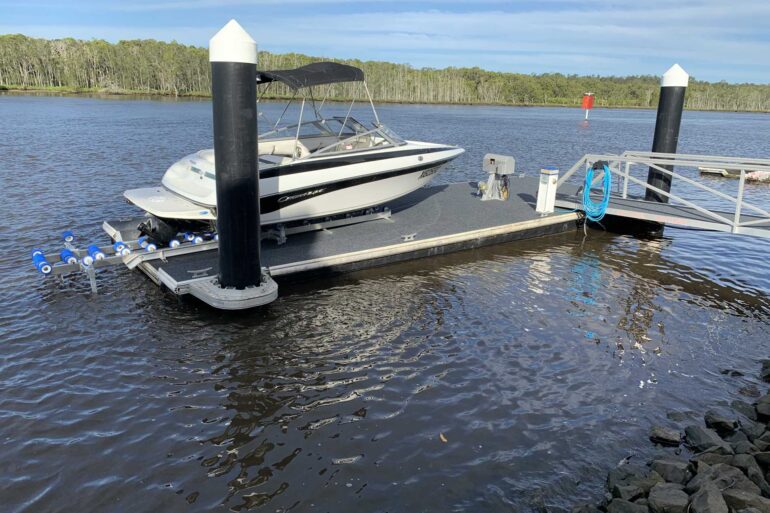
Are you new to waterfront living? Have you just moved to a new waterfront home on the Gold Coast, Sunshine Coast, Brisbane, Northern NSW, without a pontoon? If you answered yes to both these questions, then I bet getting some form of a floating dock in place is at the top of your ‘things to do list’. I also bet the top question you have regarding floating docks is how do you keep them in place?
If this question is puzzling you and you’re keen to learn more, then you’ve landed on the right page! Here at Micks Marine Maintenance, we’re pontoon specialists. Thus, we know more than a thing or two about floating docks and the options for keeping them in place. Today, we will discuss the options, which will not only answer this pressing question but provide food for thought as to which would best suit your new home.
Cable System
The floating dock component of a cable system pontoon is commonly held in place by stainless steel cables which span from the shore to the dock in an X pattern (crossing over one another from left to right). Cables work in conjunction with a gangway. The gangway prevents the floating dock from moving closer or further away from shore while the cables prove stability and prevent left and right movement over the water. This set up works as a hinge so the cables and the gangway on the land end all need to be in alignment with one another to ensure the hinge movement can occur.
Cables are an affordable option and are best suited for waterfronts with rocky terrain and calm waters.
Click here to find out more about Cable Pontoons.
Strut Arm System
Floating docks may also be held in place by one (sometimes two) strut arms. Strut arms work similarly to a cable system, in the sense that they span from the shore to the floating dock and work in conjunction with a gangway to hold the dock in place and use the hinge movement once again. The gangway prevents the floating dock from moving closer or further away from shore while the strut arm provides stability. The strut arm and gangway are at each end of the floating dock, preventing left and right movement over the water.
Strut Arm systems are the mid-range option and are best suited for waterfronts with rocky terrain and calm waters.
Click here to find out more about Strut Arm Pontoons.
Piled System
Piles are the third option for keeping a floating dock in place. Unlike cables and strut arms, piles do not touch the shore meaning if you have a beach area this is not compromised by cables and struts, nor do they require a gangway’s support to keep the dock in place. Rather than spanning horizontally from the shore to the floating dock, they span vertically through the floating dock – pinning them in place. Piles alone prevent floating docks from moving closer or further from shore or left or right with the water’s movement. However, they do allow the floating dock to move up and down with the tide, which is a significant benefit that Jetties cannot offer.
Piles are a superior option and are best suited for waterfronts with rock-free terrain and rougher waters.
Click here to find out more about Piled Pontoons.
Conclusion
How do you keep a floating dock in place? Well, there are three main options; with cables, one or two strut arms, or one or more piles. Which you choose will depend on the water conditions of your lake/canal/river etc., and your budget.
In calm waters, cables are commonly used to hold floating docks in place. They cross over one another to provide stability to the floating dock, which extends from the shore by a gangway. Strut arms are also a popular choice in calm waters. They work in a very similar manner to cables, but in most cases, only one strut arm is required. It extends from the shore to the floating dock, holding it in place. A gangway at the other end of the dock provided balance. Piles are the last option, which is best suited for rougher waters and sandy seabeds. Unlike cables and strut arms, piles have no connection to shore. Rather, they provide stability from drilling down into the seabed. They can hold a floating dock in place with or without an added gangway.
Which option will you choose for your new home? It may be more a case of which options best suits your waterfront location and personal requirements, for example, the size of the vessel which you intend to accommodate.
To determine which pontoon/floating dock option is best for you, give the team at Micks Marine Maintenance a call. We are more than happy to come to your location, review your waterfront and provide a no-obligation quote based on which is best for you.